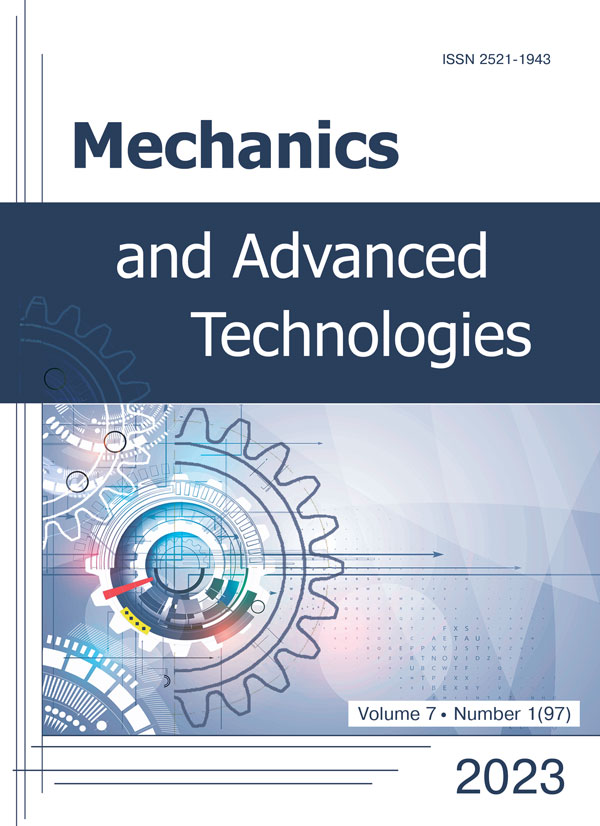Numerical modeling of internal flows in tanks with baffles
DOI:
https://doi.org/10.20535/2521-1943.2023.7.1.270308Keywords:
liquid tank, liquid resonant oscillations, distribution of shock pressures, inertial flows dampingAbstract
The proposed article presents the materials of experimental and mathematical studies of internal inertial flows of an incompressible liquid during its fluctuations in tanks. An analysis of modern problems related to the harmful effect of liquid resonant splashing on tank structures, as well as on the trajectory and nature of the object movement itself with the liquid, was carried out.
The use of damping baffles and guide devices in similar closed flows allows to fundamentally change the structure of internal flows, reducing gradients of shock pressures in flows, as well as redistributing the main liquid inertial effects. Numerical modeling of such flows qualitatively confirms the results of experimental studies and allows us to build a rather complex three-dimensional development picture of fluctuations in fluid flows.
In addition to the use of the damping baffles structures, it is proposed to make the plane of baffles perforated with different degrees of permeability due to the diameter of the holes and their number. The effect of hydraulic resistance occurs when flow energy is lost due to overcoming artificial obstacles in the form of holes of small diameter. Thus, the shock effects of the flow on the walls of the tank are predicted to have a smaller amplitude and duration.
The use of the proposed dampers labyrinth structures allows to control the force effects of the liquid only by hydraulic means and thus reduce the number and dimensions of the internal guide devices.
References
- K. Modaressi-Tehrani, S. Rakheja and I. Stiharu, “Three-dimensional analysis of transient slosh within a partly-filled tank equipped with baffles”, Vehicle System Dynamics, vol. 45, no. 6, рр. 525–548, Jun. 2007. DOI: https://doi.org/10.1080/00423110601059013.
- X. Zheng, Y. You, Q. Ma, A. Khayyer and S. Shao, “A Comparative Study on Violent Sloshing with Complex Baffles Using the ISPH Method”, Appl. Sci., vol. 8, no. 6, p. 904, 2018. DOI: https://doi.org/10.3390/app8060904.
- U. O. Ünal, G. Bilici and H. Akyıldız, “Liquid sloshing in a two-dimensional rectangular tank: A numerical investigation with a T-shaped baffle”, Ocean Engineering, vol. 187, p. 106183, 2019. DOI: https://doi.org/10.1016/j.oceaneng.2019.106183.
- E. Zhang, W. Zhu and L. Wang, “Influencing analysis of different baffle factors on oil liquid sloshing in automobile fuel tank”, Proceedings of the Institution of Mechanical Engineers, Part D: Journal of Automobile Engineering, vol. 234, no. 13, pp. 3180-3193, 2020. DOI: https://doi.org/10.1177/0954407020919584.
- V. A. Kovalev, “Struktura tsirkulyatsionnykh techeniy zhidkogo topliva v rezervuarakh kosmicheskogo apparata”, in XXIV Mizhnarodna naukovo-tekhnichna konferentsiya “Hidroaeromekhanika v inzhenerniy praktytsi”, Kyiv, Ukraine, 2019, pp. 34–38.
- V. A. Kovalev, “Opredeleniye gidrodinamicheskogo soprotivleniya stabilizatorov v toplivnykh bakakh kosmicheskogo letatel'nogo apparata”, Vestnik Natsional'nogo tekhnicheskogo universiteta Ukrainy "KPI", Mashinostroyeniye, vol. 1, no. 42, pp. 107–111, 2002.
- L. Kullman, “Unsteady viscous fluid flow in a rotating sphere”, Periodica Polytechnica of Mechanical Engineering, vol. 26, no. 1, pp. 39–54, 1982.
- C. Hubert, Behavior of Spinning Space Vehicles with Onboard Liquids. Technical Report B3007, Hubert Astronautics, Purcellville, Virginia, 2003.
- A. Kageyama, H. Ji, J. Goodman, F. Chen and E. Shoshan, “Numerical and Experimental Investigation of Circulation in Short Cylinders”, Journal of the Physical Society of Japan, vol. 73, no. 9, pp. 2424–2437, 2004. DOI: https://doi.org/10.1143/JPSJ.73.2424.
- P. Griffin, I. Ballinger, D. Jaekle and A. Jackson, “Design and manufacture of a fuel tank assembly”, in 39th AIAA/ASME/SAE/ASEE Joint Propulsion Conference and Exhibit, Huntsville, Alabama, 2003. DOI: https://doi.org/10.2514/6.2003-4606.
Downloads
Published
How to Cite
Issue
Section
License
Copyright (c) 2023 Василь Анатолійович Ковальов, Олександр Шибаєв, Вей Ченьюй

This work is licensed under a Creative Commons Attribution 4.0 International License.
Authors who publish with this journal agree to the following terms:
- Authors retain copyright and grant the journal right of first publication with the work simultaneously licensed under CC BY 4.0 that allows others to share the work with an acknowledgement of the work's authorship and initial publication in this journal.
- Authors are able to enter into separate, additional contractual arrangements for the non-exclusive distribution of the journal's published version of the work (e.g., post it to an institutional repository or publish it in a book), with an acknowledgement of its initial publication in this journal.
- Authors are permitted and encouraged to post their work online (e.g., in institutional repositories or on their website) prior to and during the submission process, as it can lead to productive exchanges, as well as earlier and greater citation of published work











